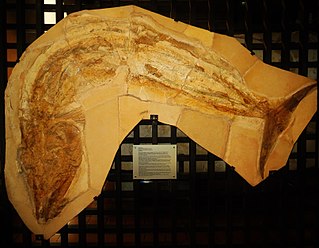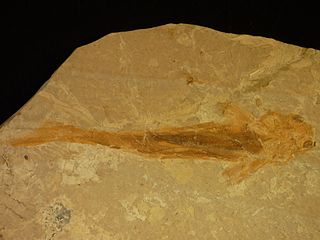
Cryptoclididae is a family of medium-sized plesiosaurs that existed from the Middle Jurassic to the Early Cretaceous. They had long necks, broad and short skulls and densely packed teeth. They fed on small soft-bodied preys such as small fish and crustaceans. The earliest members of the family appeared during the early Bajocian, and they represented the dominant group of long-necked plesiosaurs during the latter half of the Jurassic.
Bobbichthys is an extinct genus of marine ray-finned fish that lived in what is now Chile during the Oxfordian stage of the Late Jurassic epoch. It was a member of the Varasichthyidae, a family of potentially crossognathiform fish.
Atacamichthys is an extinct genus of marine ray-finned fish. It contains one species, Atacamichthys greeni, which lived in what is now Chile during the Oxfordian stage of the Late Jurassic epoch. Atacamichthys is the only member of the family Atacamichthyidae.

Varasichthys is an extinct genus of ray-finned fish that lived during the Oxfordian stage of the Late Jurassic epoch. It contains one species, Varasichthys ariasi, fossils of which have been found in the Domeyko Range of Antofagasta Region, northern Chile. It has been placed in the family Varasichthyidae together with the genera Bobbichthys, Domeykos, Luisichthys and Protoclupea.
Chongichthys is an extinct genus of marine ray-finned fish that lived during the Oxfordian stage of the Late Jurassic epoch. It contains one species, C. dentatus from the Quebrada El Profeta of Chile. It is named after Chilean geologist Guillermo Chong.
Hungkiichthys is an extinct genus of prehistoric bony fish that lived during the Late Jurassic epoch.
Oligopleurus is an extinct genus of prehistoric bony fish that lived during the Kimmeridgian stage of the Late Jurassic epoch.
Luisiella is an extinct genus of prehistoric bony fish that lived during the Kimmeridgian stage of the Late Jurassic epoch. Fossils of the genus have been found in either the Cañadón Calcáreo Formation or Cañadón Asfalto Formation in Chubut Province, Argentina.

Leptolepides is an extinct genus of prehistoric ray-finned fish that lived during the early Tithonian stage of the Late Jurassic epoch.
Austropleuropholis is an extinct genus of freshwater ray-finned fish that lived during the Late Jurassic. It contains a single species, A. lombardi, from the Kimmeridigian of the Democratic Republic of the Congo, from the terrestrial/freshwater series of the Stanleyville Formation.

Ainia is an extinct genus of prehistoric ray-finned fish that lived during the Kimmeridgian stage of the Late Jurassic epoch. It contains a single species, A. armata, known from the famous Solnhofen Limestone of Germany. It is a distant relative of the bowfin, although it is more closely related to genera such as Caturus and Osteorachis.
Protoclupea is an extinct genus of ray-finned fish that lived from the Oxfordian to the early Tithonian stage of the Late Jurassic epoch. It contains one species, Protoclupea chilensis, fossils of which have been found in the Domeyko Range of Antofagasta Region, northern Chile. The genus has been placed in the family Varasichthyidae together with the genera Bobbichthys, Domeykos, Luisichthys and Varasichthys.
Eugnathides is an extinct genus of prehistoric bony fish that lived from the Oxfordian to the early Tithonian stage of the Late Jurassic epoch. Eugnathides may have been similar to Sphaerodontes.

Asthenocormus is an extinct genus of large marine pachycormiform ray-finned fish. It contains a single species, A. titanius. A member of the edentulous suspension feeding clade within the Pachycormiformes, fossils have been found in the Upper Jurassic plattenkalks of Bavaria, Germany.

Eurycormus is an extinct genus of prehistoric bony fish that lived from the Callovian stage of the Middle Jurassic epoch to the early Tithonian stage of the Late Jurassic epoch.

Macrosemius is an extinct genus of macrosemiid fish known from the Late Jurassic of Germany.

Orthocormus is an extinct genus of prehistoric pachycormiform bony fish. It is known from three species found in Late Jurassic (Kimmeridgian) aged plattenkalk deposits in Bavaria, Germany. The species "Hypsocormus" tenuirostris Woodward 1889 from the late Middle Jurassic (Callovian) Oxford Clay is not closely related to the type species of Hypsocormus, and is more closely related to Orthocormus + Protosphyraena, and thus has sometimes been referred to in open nomenclature as Orthocormus? tenuirostris. The species of Orthocormus reached over a metre in length, and are thought to have been pelagic predators.
Pholidophoristion is an extinct genus of stem-teleost ray-finned fish that lived in what is now Europe from the Late Jurassic to the Early Cretaceous.

Peipiaosteus is an extinct genus of prehistoric chondrostean ray-finned fish. Its fossils are found in the Early Cretaceous Jiufotang Formation, Pani Lake, Liaoning Province, China.
The Jagua Formation is a Late Jurassic geologic formation in the Sierra de los Órganos and Sierra del Rosario mountain ranges in Pinar del Río Province, western Cuba. Plesiosaur, pliosaur, pterosaur, metriorhynchid, turtle and dinosaur remains are among the fossils that have been recovered from its strata.










